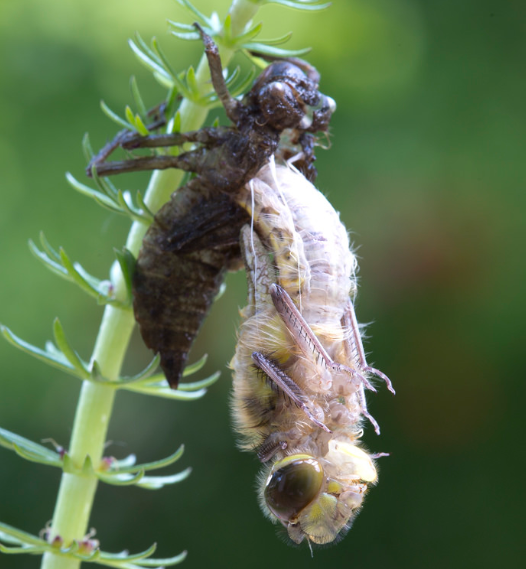Ok, so Caleb is our Program Coordinator, not technically a naturalist, but he still spends a lot of time on the trail, leading programming. It gives him a great view of our natural world. Check out his article about dragonflies!
 Summer provides the perfect season for watching metamorphosis in action.
Summer provides the perfect season for watching metamorphosis in action.
Every summer, as campers are loading and unloading at the boat docks for a paddle or a quick trip to Blackhawk Island, it is inevitable that somebody will find an unusual looking item on the dock, and ask what it is. It looks like an insect, but not any that most people have seen before, and is also hollow and very fragile to the touch. Campers are often curious and wonder if it is a dead insect that they see. Fortunately, the insect if very much alive, and might even be flying over their heads at that exact moment
Many of the insects that call Upham Woods home begin their lives underwater, before undergoing metamorphosis and become terrestrial adults. Probably the most interesting case of this is the dragonflies and damselflies. As adults, these closely related and colorful insects are fast flying predators, able to snatch up mosquitoes and flies with unmatched speed and agility. As young though, they possess a different range of adaptations, particularly dragonflies. The aquatic dragonfly nymphs boast an extendable lower jaw for catching food, an unmatched appetite, and even a jet propelled abdomen. Although these features are fascinating in and of themselves, they are almost nothing compared to the process the nymph goes through to become an adult.
When it is ready to become an adult, the dragonfly will climb out of the water onto a dry spot, where it’s old hard exoskeleton (or skin) will split open. Underneath is a new, soft exoskeleton that has the full shape of an adult, but will look squishy and vulnerable. After extracting itself from the old skin, the dragonfly will start doing push ups, which will serve to help get blood flowing through its whole body. This causes the new exoskeleton and wings to expand to their full dimensions and to harden enough to sustain it in flight. After this, the color will start to fill in, and in only one or two hours, the process is complete. However, the old exoskeleton, now called an exuvia, is just left behind, often found by Upham Woods campers or staff. Not only this, but sometimes, eagle-eyed campers can spot a dragonfly or damselfly flying around that is still not yet fully colored in. These are the young ones, probably only a couple of hours into their adulthood.
Next time you find yourself at a lake or a river, take a close look along the shoreline, and see if you can spot any of these exuvia. Wisconsin has dozens of different kinds of dragon and damselflies, and each one leaves behind a little token to its aquatic life when it leaves the water to start adulthood.



